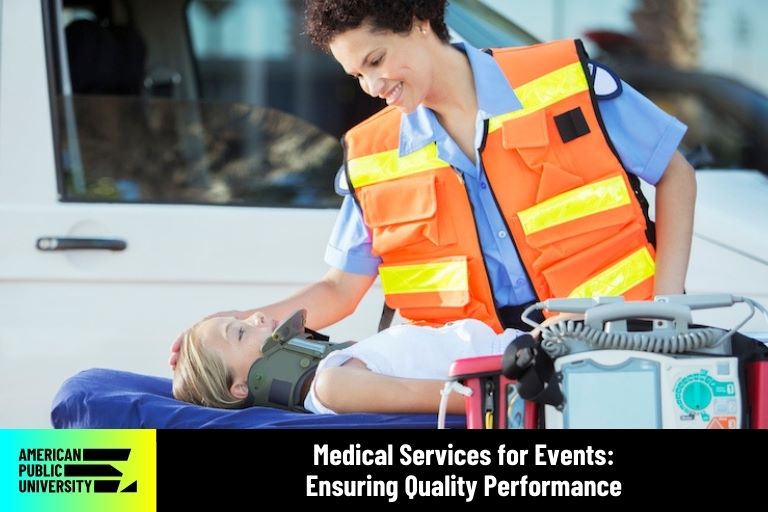By Dr. Randall W. Hanifen | 10/23/2023

Imagine that there is an announcement that a large music festival will come to your community, and that fire and other services will be needed. To start the planning process for providing medical services for events, for instance, there are several questions that will need answering, such as:
- What medical services does the event need?
- What teams – such as paramedics or doctors – will provide medical support to attendees?
- How many people will attend and what date (or dates) will the event take place?
- What will the site support in terms of logistics and where is its location?
- What are the safety considerations?
A Unified Command Is Vital for Special Events
Special events will typically need fire, emergency medical services (EMS), and security. These services can exist individually, but they will only be effective if the plans work in a unified format.
This unified format is especially important when fire, EMS, and security are being provided by local government resources. A community must still have firefighters, emergency medical technicians (EMTs), and police officers available to help other areas of the community, even when a large event is underway.
The planning should use Incident Command System (ICS) forms to allow the overall plan to morph into a disaster management plan if needed. Additionally, these forms provide useful and necessary information, such as objectives, work assignments, and communications plans.
By using standardized ICS forms, you can ensure that everyone working at large events does not have to learn a new format. For large-scale events they attend later, they will be more accustomed to this type of system. Emergency management agencies typically pay a considerable amount of money to certify their personnel in the National Incident Management System (NIMS), so it is more cost-effective to use people who are already trained in NIMS.
For large events, the Incident Action Plan (IAP) may be more than 100 pages by the time all of the contingency plans are added. However, a comprehensive document will provide all leaders of the event with a common framework and expectations from which to work. The last thing the citizens need during a disaster within the event is all agencies using a different or conflicting plan on the front lines of the event.
It Is Useful to Have an Early Meeting with Event Organizers
Ideally, fire, EMS, and police leaders should meet with event organizers as soon as possible. It is important to understand their plans and expectations.
While we know every event organizer desires to keep their costs low, it is also necessary to set realistic expectations. Depending on the event, some or all of the security, fire management, and EMS may be contracted to a private company.
This strategy may work to alleviate the need to provide the fire, EMS, and security service from the local fire departments and police forces. However, it does not give event organizers carte blanche to staff these positions according to their personal preferences.
At every concert in someone’s jurisdiction, for instance, a city, township, or county must sign off on the plan, because the lack of a plan will directly and adversely affect people in that jurisdiction. Hopefully, a jurisdiction will have legislation that supports the local government in their approval of a public safety plan. Otherwise, political and public pressure are a secondary resort of first responder agencies.
Designing an EMS Strategy
One of the first items that you will need to know from event planners is the crowd size and the event layout. These considerations will significantly affect the number of emergency crews and what transportation method can be used to reach victims.
If you are being asked to cover a densely packed crowd that is unable to move out of the way when medical care is needed, for instance, crews will be forced to reach victims on foot. This limitation significantly decreases the area a crew can cover and will necessitate more people per square mile.
If an area is not densely populated – such as parking lots – crews will need all-terrain vehicles (ATVs). Often, large fields are used for these events such as music festivals, so ATVs will be needed to traverse the terrain.
Once you determine an event’s size and population density, the next decision will need to be if EMS crews will staff a stationary first aid booth to provide on-site medical coverage. A first aid booth will require additional personnel, because mobile crews will not be able to remain in the booth if paramedics are called to someone's rescue.
It is also necessary to know if fire protection must be provided and if a local fire department is cross-trained in fire protection and EMS. Because fires are not a frequent occurrence, fire crews can help increase the number of EMS responders during peak calls for service.
Command and Control Plans
The last on-site concern is the number of command personnel and how the command system will function. If you are using a Unified Command system, it is necessary to decide who will be the operations chief/branch directors. Often, police officers, firefighters, and paramedics work well together when they are directly below the Unified Command and two branch directors control their own departments.
Possibly the most important part of command and control planning is the co-location of the commanders. If commanders in charge of medical teams and other first responder teams are able to talk to each other in the same command center, it makes interoperability so much easier.
Once you have commanders, then you need to think logistics to ensure that your operation is set up and runs smoothly. Often, event promoters are so worried about what makes them money, they tend to forget about fire, EMS, and security.
Considerations for Contingency Planning
Once you have all the regular plans completed, you need to work on contingency planning. For instance:
- What will happen if an active shooter comes to the event?
- What if advanced life support is needed from medical providers?
- What if there is some other occurrence that causes mass casualties?
- What happens if there is severe weather that impacts people’s safety?
Many organizations have policies and procedures to respond to these types of events. However, the unexpected still happens; most of these policies do not account for responders in the middle of the event or for a certain crowd size to be involved in an active shooter event.
An examination of events such as the Las Vegas shooting can serve as useful information for first responders. It is useful to understand the chaos that can occur after a mass casualty event, especially if fire and police command personnel are not co-located in the area. Beyond just being able to respond to mass casualties, planners must design the layout of their triage, treatment, and transport areas.
Most venues were not designed to have any of these facilities built into their layout. As a result, fire and EMS leaders must know what areas to take over at the event and how they will get the necessary resources to those sites.
Weather is one of the most common events where contingency plans are necessary. For instance, what do you do when severe weather threatens many people in outdoor areas, often in a remote area without shelters? Can you send event participants to their cars or where they were shuttled to the site? Many of these quandaries need to be worked out with professional promoters prior to large events such as outdoor concerts.
Flexibility During Events Is Necessary
Despite the best plans, you will need flexibility during large events, as equipment or personnel promised by event promoters may not be present to ensure everyone's safety. Additionally, you may find that some items were not needed or other items were needed but did not arrive in time.
I would advise having the capability to break up crews and some personnel who can have multiple assignments throughout an event, such as a cross-trained team capable of handling both fire and EMS duties. This flexibility – if used at all levels – will help alleviate the stress of large events and will ensure that professional services will get to event participants in a timely manner.
American Public University and Emergency and Disaster Management Degrees
American Public University offers a range of bachelor’s and master’s degrees to help equip adult learners with the knowledge typically necessary to handle emergency and disaster management situations. These degrees include:
- B.A. in Emergency and Disaster Management
- B.S. in Fire Science Management
- M.A. in Emergency and Disaster Management
- M.A. in Emergency and Disaster Management and Homeland Security
Dr. Randall Hanifen is a faculty member in the School of Security and Global Studies, teaching courses in emergency and disaster management. He holds an associate degree in fire science and a bachelor’s degree in fire science from the University of Cincinnati, a master’s degree in executive fire service leadership from Grand Canyon University, and a Ph.D. in homeland security from Northcentral University.
He also serves as an Assistant Fire Chief of Operations at a medium-sized suburban fire department in the northern part of the Cincinnati area. Randall is the CEO/principal consultant of an emergency services consulting firm, providing analysis and solutions related to the organizational structuring of fire and EMS organizations. He is the chairperson and operations manager for a county technical rescue team.
From a state and national perspective, he served as a task force leader for one of FEMA's urban search and rescue teams, which responds to presidential-declared disasters. He is the associate author of “Disaster Planning and Control” (Penwell, 2009), which provides first responders with guidance through all types of disasters.

